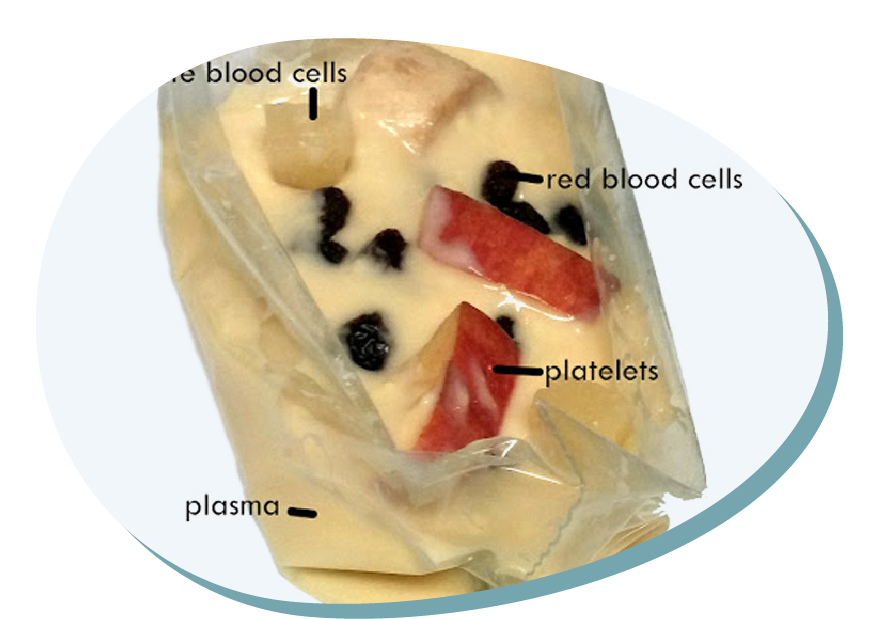What’s Inside Your Blood Science Experiment – An Edible Model
Type of resource: website
Web address http://preschoolpowolpackets.blogspot.com/2016/02/Whats-Inside-Your-Blood-An-Edible-Model.html
Language: english
Description
Creating an edible model of blood – recognizing the components of human blood, understading their function in human body.
Scientific concept introduced
Blood
Plasma
Erythrocytes
Leukocytes
Thrombocytes
Creative and critical thinking
–
Mathematical reasoning
–
Scientific thinking
Asking questions
Analyzing and solving problems
Drawing conclusions
Learning how to learn
–
Additional
Enriching vocabulary
Learning to work in a team (sharing ideas)
Following the rules of safety
Fine motor skills
https://www.youtube.com/embed/5RsRWgj_KNA?feature=oembed
What’s Inside Your Blood Science Experiment – An Edible Model
Overall aims
Enriching knowledge and understanding concerning the essence and ingredients of human blood (plasma, red blood cells, white blood cells, platelets)
Developing fine motor skills while building the blood model
Developing the abilities to observe
Developing the cognitive abilities like: attention, concentration and thinking
Organizing the environment for co-operation
Vocabulary – keywords should be understood
Blood, plasma, erythrocytes, leukocytes, thrombocytes
Expected learning outcomes (operational aims)
The child explains the blood structure, names its parts and explains the different parts functions;
The child can construct edible blood model using food ingredients – he/she improves motor and cognitive skills
The child is able to cooperate in a team, playing different roles
STEM skills – to which the learning unit is related to
CORE STEM SKILLS
Learning to think and discover
– asking questions
– analyzing and solving problems
– drawing conclusions
ADDITIONAL SKILLS
Learning to work in a team (sharing ideas)
Following the rules of safety
Fine motor skills
Teaching methodologies/activity outline
1. Introduction
What is blood? What do you know about human blood?
What does the blood consists of, what are the parts of blood?
The movie can be used: (Once upon the time… Life) e.g.
https://www.youtube.com/watch?v=7AWfzy7wdv4
2. Building the edible blood model following the instruction and explanations from the website:
http://preschoolpowolpackets.blogspot.com/2016/02/Whats-Inside-Your-Blood-An-Edible-Model.html
3. Eating the model
4. Artistic summary – drawing the blood model built during class
Assessment of learning
Preparing a drawing – my own model of blood
Equipment and materials to be used in learning unit (tools, ingredients etc)
– Plastic bag or long container illustrating the blood vessel
– Yellow pudding
– Raisins
– Bananas
– Pineapples
– Apples
The children can also think about their own ingredients to be used in a blood model.
Kind of setting
Classroom or preschool kitchen
References – source
http://preschoolpowolpackets.blogspot.com/2016/02/Whats-Inside-Your-Blood-An-Edible-Model.html
http://creeksidelearning.com/more-kitchen-science-whats-inside-a-drop-of-blood/
Blood in a bottle:
https://www.rundesroom.com/2012/10/our-classroom-was-covered-in-blood-today.html
What’s Inside Your Blood Science Experiment – An Edible Model
1. Usefulness for STEM education – integrating content of different disciplines
Cross-curricular character of the resource

The range of S-T-E-M subjects included

The presentation of possibilities of including artistic activities (STEAM approach)

2. Expected learning outcomes
Consistency (links) with preschool core curriculum

Communicativeness of description

3. Methodology of teaching
Clarity, communicativeness of instructions for teachers

Meaningful learning – using practical life problems

Original idea

The level of ease in implementing the methodology to preschool age children

The level of ease in preparing necessary ingredients, materials and equipment needed

4. Sustainability
Ecological characteristics of materials/ results

Supporting healthy eating habits

Low ecological footprint

Possibilities of inclusion (respecting cultural diversity and food intolerances)

5. Class management
Using differentiated forms of work – individual, team work etc.

Individual work

Team work

Whole group
6. Time management

Short activity (10-15 minutes)

Medium activity (20-30 minutes)

Long activity (1 hour or more)

Very long activity (1 day or more)
PDF: https://www.printfriendly.com/p/g/ATsLd4

